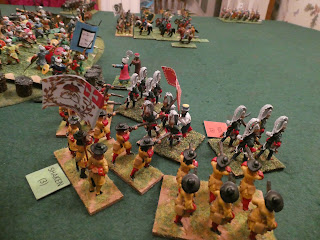The inspiration for this week's game came from a post on the League of Augsburg blog. (link). The game pictured was on a far larger scale than I could contemplate, but it could provide a basis for an experiment pitting our 'Grand Alliance' figures against some Ottomans. Looking at the maps in Wheatcroft's "The Enemy at the Gate" I settled on Lorraine's advance close to the Danube. The allied force was predominantly infantry (12 battalions, organised in 3 brigades) with some cavalry and artillery support. Their task was to clear the Ottomans from an earthwork and then advance eastwards towards the main defences. Opposing them was 1 unit of levy infantry, a small janissary unit, a small unit of azab skirmishers, one unit of horse archers, one of light cavalry and a unit of sipahi. The Ottoman commander could call for supports, but what actually arrived depended on a dice roll when the reinforcements were due to enter the table.
Above is a photo of the terrain for the table. The river is fordable for infantry and cavalry, artillery need to use the ford; the boggy area is impassable to all troops. NB the cavalry in the lower left of the photo are not deployed there, they will enter behind the infantry.On the Ottoman left, the archers had been shooting at the infantry, but inflicting little damage. With the allied cavalry taking it's time to get forward, it was up to the second line of infantry to take some action. A few volleys were sufficient to force the archers back and relieve the pressure. Back on the right the sipahi charged the Danish infantry. Charging home through the close range volley they inflicted heavy casualties which routed their opponents. However, they had taken sufficient casualties themselves to prevent them following up. To avoid the volleys from a supporting regiment they had to fall back to rally.
By now, the allied cavalry had moved forward and made their presence felt. On the right, the Erbach regiment charged the horse archers, who attempted to evade, but were caught before they could move. It was a rather one-sided affair, with Erbach coming through unscathed while the archers fell back. Erbach followed up, pushing the Ottomans back again. Before the archers could recover they were charged again by Erbach and driven from the field.
 |
| Erbach drive off the Ottoman horse archers |
 |
| The Janissaries routed |
Fortunately the allied infantry had suffered heavy losses and needed time to rally before they could continue to advance. In the redoubt, the levy ignored this reverse and stood to their front.
The Ottoman cavalry arrived in the nick of time. A unit of sipahi charged Erbach, confident in their superior numbers. They received short shrift from their opponents, who quickly drove them from the field. On the opposite flank, the original unit of sipahi, now rallied charged the allied infantry and stopped them in their tracks. The position there was still perilous, the Veningen Gendarmes were working round the flank of the sipahi and only a unit of light cavalry was in a position to stop them.
The Ottoman commander ordered the infantry reinforcements to fall back to the next line of defence, as to advance any further would achieve little and may well only serve to increase Ottoman losses. He then mustered what forces he could and began to try and get them back to the main line of defence.
An enjoyable evenings game. As you may expect, the allied infantry fire power could handle most Ottoman attacks. The Ottomans could perhaps have done with more cavalry and they could certainly have done with more space, allowing them to threaten the flanks of the allies more effectively. [A point made by Bruno Mugnai in his recent book ] . Whilst compiling this post I happened to have a telephone conversation with my friend Alasdair, a former wargaming opponent now living in Scotland. He said that he felt that even with his 12 ft table there was not enough space on the flanks to really represent the flanking tactics of the Ottoman army using 25mm figures. Perhaps I should have gone for 15mm or even 10?




Interesting post, like viewing your Ottoman Army, and I have always thought the Essex late 17th century 28mm range was very good.
ReplyDeleteMichael
I have fought a number of games where one player is warned that a flank attack might occur, but has no knowledge which side of the table, and the other player is obliged to dice to determine if his flanking cavalry will make an appearance . Its always added some 'spice' to the game, not least when the flank attack fails to materialise (got lost?).
ReplyDeleteMichael
Thank you Michael.
ReplyDeleteSteve picked up the Essex figures off ebay at a reasonable price, they seem to be 'out of fashion' at the moment. We like the idea that the expected reinforcements may just not arrive, Ligny for example? The idea behind the Ottoman reinforcements was that the scenario was set in a forward position and the decision on what forces to send and when, lay with a superior further back, so was out of the control of the man on the spot. As you say, it all adds to the fun.
David
What a great looking game. The figures look just as good. There's nothing wrong with Essex figures, I like them in 15 and 25.
ReplyDeleteThanks Ray. I agree with your comment about Essex. Most of my WSS Austrians are Essex and I have a fair number within my 15mm Napoleonic collection.
DeleteDavid